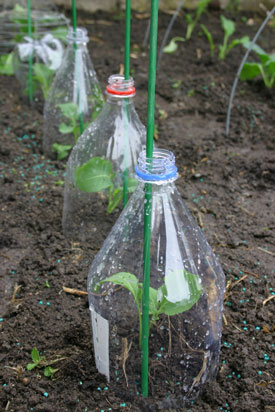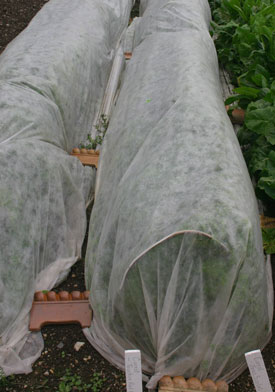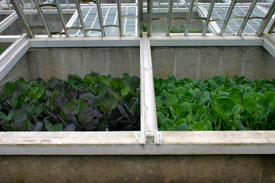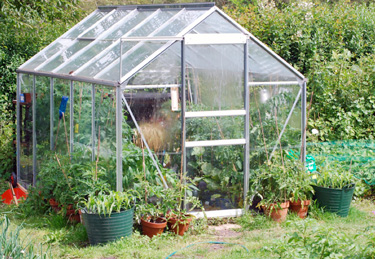Grow under cover
Spot a backyard greenhouse and you could be forgiven for imagining a resident 'expert' or 'plant-nut'. But these days, greenhouses aren't just for diehard gardeners. They’re for anybody - from novice to expert - whatever the climate.
Modern materials and lower importing costs have brought us a wide range of affordable, home garden greenhouses. In particular, as more and more of us become interested in growing our own food, we are beginning to switch on to the wisdom of extending our growing season by going undercover for part of the year.
A greenhouse is a very useful thing. For foodies, it’s a great way to have early and late crops. For thrifty gardeners, it increases the potential for propagating our own plants via seeds and cuttings, and for the plant collectors, a greenhouse means we can grow those desirable treasures we couldn’t grow outdoors.
There is another good reason to have a greenhouse – it’s simply a lovely place to be in winter.
Cold frames and cloches
If you simply want to create a warm sheltered environment with room enough for the plants, cold frames and cloches do a very good job, without the expense of a greenhouse. These can be purchased ready to go, or as easy to assemble kits, or you can make your own using recycled materials.
A cloche (French for ‘bell’) can be as simple as a plastic drink bottle or old preserving jar. The original garden cloche was a pretty bell shaped jar, of which there are now some very attractive plastic lookalikes. Cloches can be removed during sunny days and put back in the evenings. A cloche made from a row of wire half-hoops covered in plastic is both practical and versaltile, if not quite as pretty. The covers can be varied according to the season and what you want to grow; frost cloth, plastic, shade cloth, bird netting or insect mesh.
Old windows make charming and effective cold frames. They look great over a brick or timber built frame, sloped towards the sun. Alternatively, make temporary walls from stacked concrete blocks or straw bales. Place your cold frame in a sheltered location with all day sun. Face it towards the sun and make sure it is easily accessible. Allow for opening to provide ventilation on sunny days. A lightweight cold frame, or one with wheels, is best if you want to move it around the garden. However, lightweight cloches need to be secured so they don’t blow away in the wind.
Bear in mind that, while protecting our plants, crop covers can also block sunlight, rain, fresh air and pollinators. Remove covers as soon as danger has passed.
Don’t let the soil under your cover dry out. To minimise disease problems, water early so that the foliage is dry before dark. In winter the surrounding soil is generally wet enough soak sideways to the roots of plants growing in small cloches.
For extra warmth at night, a cold frame can be covered with an old blanket or sacks. Plastic bottles filled with hot water then placed inside a cold frame can provide extra protection for precious seedlings on cold nights.
Tip: Set winter cloches in place before planting to pre-warm the soil.
Choosing a Greenhouse
Price
Think about how long you want your greenhouse to last. If that’s a lifetime, you will want to invest in the best you can afford. Look for warrantees and do your research thoroughly. A greenhouse that doesn’t do what you need it to do could end up being a waste of space, and money. On the other hand if all you need as a beginner is a temporary, low cost greenhouse to experiment with a few plants, there are some great compact greenhouses that are inexpensive and simple to erect.
Size
The size of your greenhouse will depend on the size of your garden and the elasticity of your budget. Space and finance allowing, it makes sense to err on the large side because as with anything (think for example of storage cupboards and decks) we always end up wanting more space. Be sure to allow room to manoeuvre if you want to enjoy being inside the greenhouse with your plants. If you have to become a contortionist to get at your plants or constantly watch where you put your feet, it may be better to go for a simple cold frame instead. A good minimum size for a home garden greenhouse, with enough room for the gardener as well as her plants, is 2.5m wide, 2.5 to 3m long with 1.8m high sides (about 2m at the apex).
The Walls
Glasshouses look lovely, especially (if you’re a romantic) the old fashioned wooden framed ones. Glass is low maintenance and long lasting - provided it doesn’t break! But glass is usually the most expensive option, and not the safest. In a garden with strong winds, children, or other means of propelling flying objects, plastic should be considered.
Plastic sheeting is inexpensive and lightweight, so only requires a lightweight frame construction. This makes it the least expensive type of greenhouse. Plastic sheeting used for greenhouses should ideally be horticultural grade. Ordinary PVC plastic may be OK to sit under but it produces poor light for photosynthesis. Horticultural plastics are designed to provide the right kind of light for plant growth.
Plastic does have a shorter life and is generally replaced more often than other materials. The cheapest plastics need replacing after a year or two. Double layer polycarbonate is another, relatively new material that offers the rigidity of glass with the safety of plastic. It is also lightweight, and cheaper to import and transport than glass, although it is more expensive than plastic sheeting. Polycarbonate withstands rocks, hail, and heavy snow loads. It has UV treatment on the side that faces the sun. Between the inside and outside wall of the polycarbonate is an air gap, providing insulation. Polycarbonate walls provide diffused light so there is no need to paint or cover with shade cloth to prevent plants scorching in summer.
The Framework
The conventional shaped, straight wall greenhouse with gable roof provides maximum interior space and air circulation. It needs a good strong foundation to support the load on the walls. The half-circle tunnel house is simple and easy to construct, but has less usable space at the sides than a conventional shaped glass house. If building a tunnel house, avoid using common PVC pipe as this is damaging to horticultural plastics.
The frame of a greenhouse must be compatible with cladding type. Glass requires a very strong, solid structure. Where there is snow or wind, strength is even more important. Metal structures may be galvanised steel or aluminium. Steel is cheaper, but aluminium is preferable because it doesn’t rust. However, when in constant contact with damp soil aluminium deteriorates, so if it is used for the base it is best to keep it slightly off the ground.
Foundations and flooring
A firm level base is essential. Some companies offer a prefabricated steel base, or you can build your own to the dimensions given by your greenhouse supplier. This may be timber, poured concrete, or brick.
Floors are best laid in gravel, which allows for easy drainage of excess water. Also, water can be sprayed on the gravel to raise humidity. For comfort and convenience, a concrete walkway may be added through the centre of the greenhouse.
Greenhouse basics
Location
Position your greenhouse for maximum sunlight. Avoid shadows from buildings and trees, not forgetting that these shadows are much longer in winter. Ideally there should be shelter from cold wind, which will cool the greenhouse down. Place your greenhouse where you can get to it easily and have a handy storage area nearby, for pots, potting mix and other paraphernalia.
Ventilation and cooling
Ventilation, the exchange of air in and out of the greenhouse, is important for healthy plant growth. Ventilation removes excess moisture, replenishes the carbon dioxide essential for photosynthesis, and prevents overheating. Effective ventilation uses a combination of doors and windows, roof and side vents. Warm air escapes upwards, drawing cool air through the sides. Ventilation needs will vary with the weather, the amount of wind protection of your site, the plants being grown, and the season (more ventilation is needed in summer). Automatic solar powered vents are an option worth considering.
Shading
On hot summer days, ventilation alone may not be enough to cool the greenhouse, and the light might be too intense for some plants. That’s when shade materials such as shade cloth or greenhouse paint come in handy. Of course you may simply decide not to use your greenhouse in the hottest part of the year.
Heating
Because heating is expensive, many gardeners opt to go without, relying on the sun’s energy and glasshouse insulation to extend our growing season later into autumn and earlier in spring without feeling the need to use it in the dead of winter. There is still much to enjoy in a greenhouse without artificial heating.
However, heating does increase the range of plants that can be cultivated throughout the year. Electric heating can be thermostatically controlled to keep the greenhouse at the optimum temperature. Simple electric oil heaters are one option.
For propagating seed and cuttings, special ready-to-use heating mats are available with thermostatic temperature controls. This allows you to put the heat exactly where you need it, near the plant’s roots. Of course, introducing electric heating assumes you have a safe, damp-proof power source available in your greenhouse.
Insulation
Preventing heat loss via good insulation is important, especially if you are paying for heating. Find out about the insulation properties of your chosen cladding material and type of construction. A lot of heat can be lost through joins too. Generally double layer polycarbonate is more insulating than glass, but this depends on the type of glass. Plastic is the least effective insulator. However, a simple plastic liner in any of the designs dramatically improves energy efficiency.
Watering
Make sure an easy water supply is close by. Careful hand-watering is ideal if you have a variety of different plants to care for, but installing an automatic irrigation system will make life easy especially if you run it on a time clock. For gardeners raising lots of plants from seed, a misting unit is a worthwhile investment.
1-May-2014

Bottle cloche

Tunnel cloche

Cold Frame

Greenhouse


